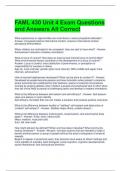FAML 430 Unit 4 Exam Questions
and Answers All Correct
What experiences or opportunities are most likely to reduce prejudicial attitudes? -
Answer- Increased positive intercultural contact, vicarious intercultural contact,
perceptual differentiation
When children are motivated to be competent, they are said to have what? - Answer-
Achievement motivation (mastery orientation)
What is locus of control? How does an external and internal locus of control differ?
What environmental factors contribute to the development of a locus of control? -
Answer- Locus of control: one's attribution of performance, or perception of
responsibility for success or failure
Age (9+ more internal), gender (girls more internal), SES (middle and upper more
internal), achievement
How is learned helplessness developed? What can be done to combat it? - Answer-
Developed as people become passive and lose motivation when placed in situations
where outcomes are unaffected by their behavior, pawns of external circumstance
Combat by praising abilities when children succeed and emphasize lack of effort when
they fail (more likely to persist at challenging tasks and develop a mastery-orientation)
What is the difference between self-esteem and self-efficacy? - Answer- Self-esteem:
value one places on one's identity
Self-efficacy: the belief that one can master a situation and produce positive outcomes
What is the difference between healthy or "selfless" self-esteem and destructive or
"prideful" self-esteem? - Answer- Selfless helps others, prideful doesn't...
What is the difference between endomorphic, mesomorphic, and ectomorphic body
types? - Answer- Endo: short, heavy build
Meso: medium, muscular build
Ecto: tall, lean build
How might altruism be defined? When and how does it develop? What community
factors contribute? - Answer- Altruism: voluntary actions that are intended to help or
benefit another person or group of people without the actor's anticipation of external
rewards
Begins to appear in preschool years, they become more aware of others' feelings and
more capable of empathy (also biological, social cognitive, cognitive developmental,
social interactional, and sociocultural theories)
, Community factors: simple social organization, traditional/rural, extended family ties,
early assignment of tasks and responsibility, ind/coll orientation, justice/duty-based
social responsibility
What type of individuals are children most likely to imitate? Why? - Answer- Peers and
parents...who are rewarded for their actions
What happens when responses are rewarded intermittently? - Answer- Resist extinction
or elimination, they become difficult to "unlearn" (aggressive acts are likely to be
rewarded intermittently)
What can adults do to discourage aggressive behavior? - Answer- Organize
environment to minimize conflicts, set standards and stick to them-consequences for
noncompliance, stop aggression immediately, give alternatives for solving problems,
anticipate possible aggressive situations, opportunities for cooperative activities, foster
helpfulness and cooperation, be a positive role model, discuss rules and reasons for
them, reward prosocial behavior
What factors influence a child's ability to resist negative peer pressure? At what age is
peer pressure most influential? - Answer- Middle childhood...
What is a moral code and how does it develop? - Answer- Involves feeling, reasoning,
and behaving; construct moral concepts according to cognitive and emotional
development from social interactions
Influenced by maturation and development, intelligence, motivation, need for approval,
self-control, and the particular situation
What are the distinguishing factors for each of Kohlberg's stages in his theory of moral
reasoning? - Answer- (Preconventional)
Stage 1: avoid punishment
Stage 2: serve one's own needs and interests
(Conventional)
Stage 3: need to be a good person in your own eyes and others'
Stage 4: keep the institution going as a whole, meet one's obligations
(Postconventional)
Stage 5: obligation to law because of social contract
Stage 6: belief in validity of universal moral principles and personal commitment to them
How does a child's development impact their moral reasoning? What is the relationship
between age and Kohlberg stage? - Answer- Development over stages is gradual,
results from many social experiences, some advance faster than others, only 25% of
US adults reason at stage 5
What are the common criticisms of Kohlberg's theory? How does it differ from Piaget's?
- Answer- Criticisms: differences between moral reasoning and moral behavior,
interviewing doesn't really measure underlying process, cultural bias, gender bias




